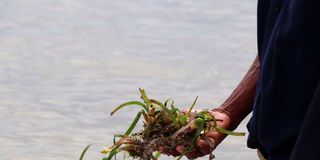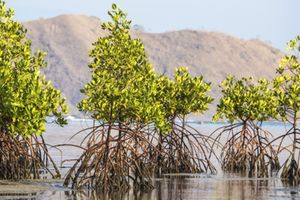Tapping into the potential of blue carbon ecosystems

There is a critical need to enhance the visibility of seagrass ecosystems.
What you need to know:
- In Kenya, major blue carbon ecosystems are the mangrove forests and seagrass beds covering approximately 61,000 hectares for mangroves and 39,693 hectares for seagrasses.
A recent workshop held in Kilifi County has provided a platform to deliberate collective actions towards harnessing blue carbon ecosystems as vital tools for nature and community livelihoods.
The national Blue Carbon Dialogue themed “Enhancing Local Level Governance of Blue Carbon in Kenya” took place on March 27 at Mnarani Beach Club. The guest of honor was State Department of Fisheries and Blue Economy PS Betsy Njagi.
It served as a platform for government agencies, civil society, expert groups, and local community organsations to provide guidance on the integration of blue carbon into the national climate and development strategies.
Blue carbon is the term used to denote carbon captured and stored by coastal wetlands, particularly mangroves, seagrass beds and salt marshes ecosystems. These ecosystems capture and store three-10 times more carbon than their terrestrial counterparts and as such could play a critical role in mitigating climate change.
In Kenya, major blue carbon ecosystems are the mangrove forests and seagrass beds. Covering approximately 61,000 hectares for mangroves and 39,693 hectares for seagrasses, these ecosystems store more than 75.0 million tCO₂ (metric tonnes of carbon dioxide equivalent) and sequester an additional 7.5 tCO₂ per hectare per year, offering significant carbon credit potential.
Over the next 20 years, blue carbon ecosystems could generate up to $440 million in revenue from carbon credits alone. This is in addition to the support value of these ecosystems to fisheries, shoreline protection, and in provisions of harvestable wood and non-wood products.
While Kenya has made significant strides in incorporating blue carbon ecosystems into policy frameworks, these frameworks have mostly focused on mangroves. Notable achievements in mangrove management include the development of the National Mangrove Ecosystem Management Plan, the National Mangrove Ecosystem Restoration Guidelines, National Mangrove Portal, Lamu Mangrove Harvesting Plan, and the Mangrove Nursery Manual. These management tools are critical and are designed to guide the sustainable management of mangrove ecosystems for climate, community and biodiversity benefits. Seagrasses, however, have received less attention, and are only addressed in the Coral Reef and Seagrass Ecosystem Conservation Strategy (2014-2018) that now requires revision. There is a critical need, therefore, to enhance the visibility of seagrass ecosystems.
The Kilifi dialogue highlighted key barriers and opportunities for integrating Kenya’s blue carbon ecosystems into climate strategies and development plans. Some of the barriers include weak policy tools for the management of seagrasses, hindering their inclusions into national strategies. Economic valuation of blue carbon ecosystems has been inadequate, lacking the input of indigenous and local knowledge necessary to inform policy and management decisions. Overlapping mandates among state actors is contributing to inadequate coordination and inconsistent management of blue carbon habitats. Further, High compliance costs and complex processes for nature markets complicate implementation of community-led blue carbon projects. International collaboration is necessary in building technical capacity, raising awareness, and mobilising resources for blue carbon.
The meeting emphasised the need to undertake policy measures to enhance blue carbon conservation and management, and capacity at local and national levels. Further, there is a need to enhance methodologies for measuring, reporting and verification of blue carbon aligned with international best practices. The workshop aslo cited the need to develop accessible platforms with linkages to state managed databases for blue carbon management as well as establish polies that recognise blue carbon inclusion in carbon market regulations.
The meeting advocated for increased internal and external climate finance to fund blue carbon ecosystem restoration and community resilience initiatives.
The national blue carbon dialogues was organised by the Kenya Marine and Fisheries Research Institute with financial support from EU’s Go Blue Project, the Natute Conservancy, Betty-Moore Foundation, World Wide Fund for Nature, The International Union for Conservation of Nature and Ocean Risk and Resilience Action Alliance, among others.
Dr Kairo is the chief scientist at the Kenya Marine and Fisheries Research Institute.


